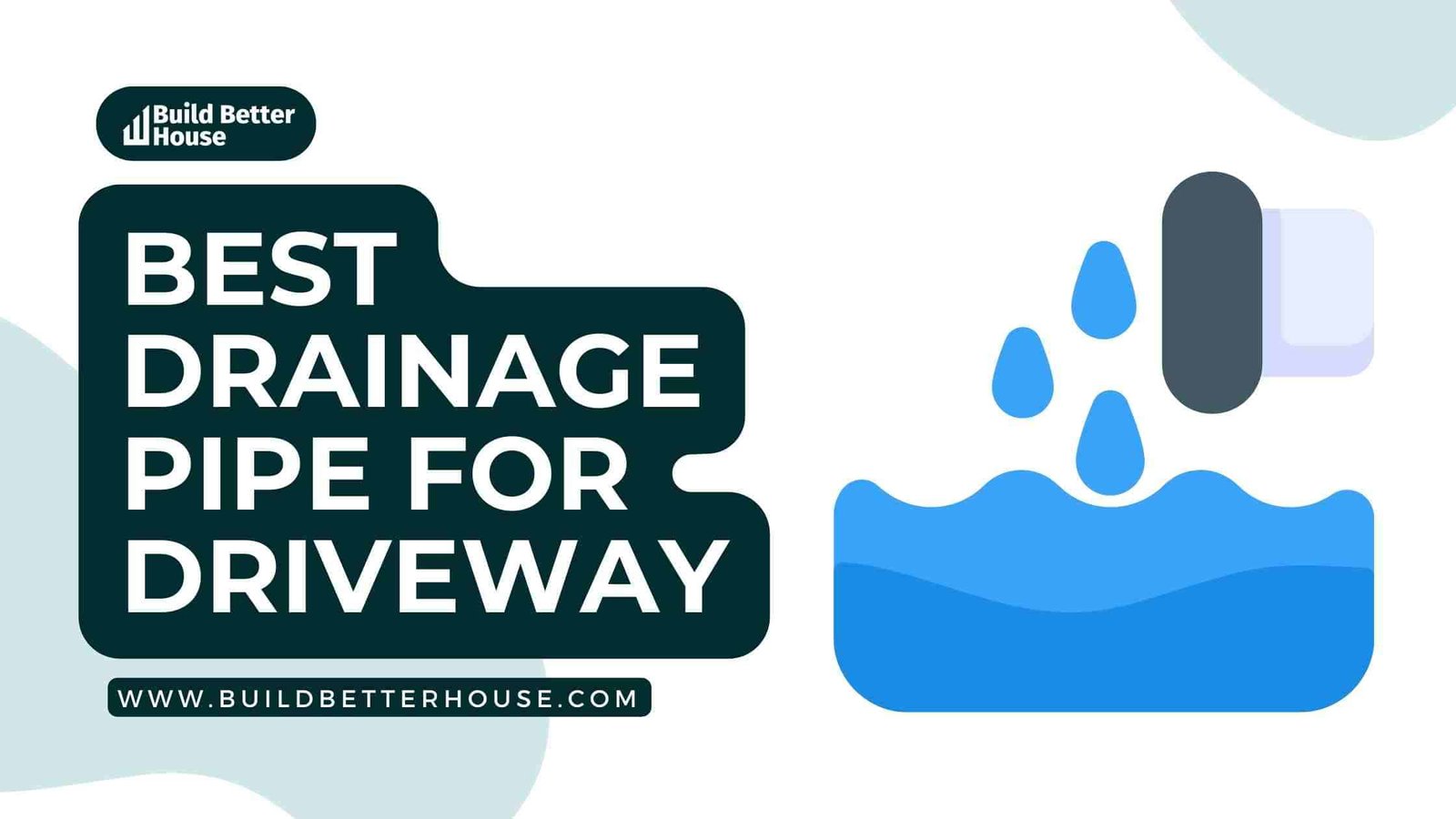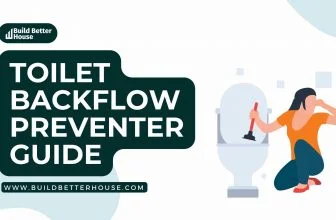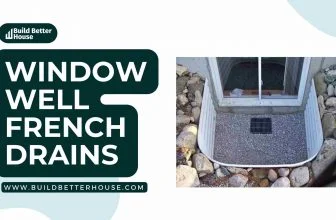Best Drainage Pipe For Driveway And Guide For Installation

Do you want to set up a drainage pipe for driveway, but you need to figure out where to start? This article will explain how to install a driveway culvert pipe to help you with drainage and prevent flooding.
Whether you’re installing a new driveway or renovating the one you have, a drainage pipe is critical to preventing erosion and flooding. Installing a drainage pipe for driveway may not be difficult, but choosing the correct pipe may be.
A drainage pipe for driveway is a critical part of water drainage. Along with selecting the best material and design, you must evaluate several other factors to determine the proper pipe for the culvert.
This guide will teach you how to install a drainage pipe for driveway, so water can drain from it and not enter the basement of your house.
What is a Driveway Culvert?
A driveway culvert (also known as a drainage pipe for driveway) is a small pipe that runs parallel to a driveway and lets water flow down a drainage ditch.
These drainage pipes are at the bottom of a channel drain or trench drain that removes surface water from a nearby road to protect the surrounding soil.
Corrugated, PVC, and concrete are often used to construct these drains because they last a long time – but do not bear loads. Only water may flow through these passages. Gravel is frequently incorporated to slow down water flow.
What factors affect pipes under a driveway?
PVC and conjugated plastic or steel pipes are the most convenient and preferred drainage pipe for driveway aside from copper, concrete, and other materials.
Aside from choosing the suitable material, there are numerous other variables to consider when selecting the best drainage pipe for driveway. These factors include:
1. Vehicle’s Weight
A drainage pipe for driveway should be sturdy to withstand the weight of the vehicles that park or drive through it. A car weighs between 2,500 and 4,500 pounds on average.
Make sure you choose a material that will withstand this weight without wearing it out over several years when selecting a drainage pipe.
It will help if you place lines at least 12 inches deep from the surface to improve the stability and endure the weight.
2. Changes In Temperature
Due to their flexibility, plastic pipes (PVC, for example) can expand or shrink up to five times more than metal pipes (such as steel or iron). These changes may eventually wear out the pipe, resulting in leaks.
For example, PVC pipes may shrink in cold weather, exacerbating the damage. A perforated drain pipe might solve this issue without any further problems.
When dealing with temperature changes like these, ensure you choose a compatible drainage pipe for driveway.
3. Drainage Capacity
The drainage pipe for driveway you select will depend on how much water you need to remove. For example, a PVC pipe with a half an inch diameter has more drain capacity than a 5/8-inch drainpipe.
You must understand how much water must be drained to choose an appropriate drainage pipe for driveway.
What are the different types of drainage pipes?
Studying drainage pipe types for driveways can simplify your search and guarantee proper operation. Here are the different types of lines you can use for driveway drainage:
Corrugated Pipes
Corrugated pipes are manufactured with grooves and ridges so they can be connected to other pipe joints and bends without difficulty.
The grooves and ridges are parallel to the installation site. Corrugated pipes are a cost-efficient alternative if you want a budget buy.
The single-walled plastic pipe is made from the most robust plastic available, HDPE. The pipe’s interior is smooth, allowing maximum water flow with a corrugated metal pipe exterior.
Corrugated tubes are durable, lightweight, and flexible, making them impact-resistant. The dual-wall corrugated pipe has two layers of HDPE fused for increased durability.
The exterior can withstand external conditions, while the interior can maintain a consistent water flow.
PVC Drainage Pipes
PVC drainage pipes are the most popular choice for indoor and outdoor applications. Because they are easy to install and maintain for the long term, they are very desirable.
The PVC pipes are made from a synthetic polymer that handles extreme weather conditions and can handle more filth and debris than a typical indoor pipe.
Because they allow for smooth water flow, they are also called smooth-walled pipes.
Perforated Drain Pipes
PVC and corrugated pipes come in either solid or perforated varieties. Using perforated pipes, drain rainwater or stagnant water from lawns, yards, and other outdoor areas.
Perforated pipes are an optimal alternative for drain pipes on a driveway in a place with heavy rainfall, as these pipes can easily remove rainwater. Because of these pipes’ tiny slits or holes, water can quickly drain through them.
Because perforated pipes are so easy to clog, they need frequent upkeep. Perforated pipes are the least pricey and simple to swap with their peers.
Metal
Metal pipes are available in a variety of metals. There are pros and cons to using metal for lines. On the one hand, they are very durable.
On the other hand, many homeowners believe that metal pipes have an expiration date. Regardless of the metal, metal pipes are susceptible to corrosion.
Copper
Copper is less corrosive than most metals. You can find copper pipes in houses. However, copper is also utilized in underground drainage systems, such as underneath your driveway.
If you want a metal pipe for drainage, copper is the choice. Copper doesn’t require any coating and will do well with rocks and soil.
Many other types of pipes used for a driveway culvert include cast iron, polyethylene, and concrete. However, these choices need to be more effective.
How To Install A Driveway Culvert?
A pipe runs the length of your driveway, ending in a drainage ditch. A trench drain or channel drain is placed horizontally beneath the line.
Here is a list of the tools required to install a drainage pipe for driveway, along with step-by-step instructions.
Tools You’ll Need
- A permit from local authorities
- Trench digging machine
- Measuring tape
- A plastic pipe or concrete pipe for driveway
- A shovel
- Gravel
- Drain gate
Before digging the drainage pipe for driveway, check with your city’s authorities to determine if a permit is required and whether fuel lines are buried in the area.
Step 1. Plan and measure the drain
Before you install a new drainage system, you must first measure and plan how long the pipe should be and how deep you should dig. Remember, twice-measure, once-cut.
If you plan the drainage system, you may avoid digging too close to a road or foundation, which may cause another drainage issue.
Step 2. Dig the trench
It is time to dig the trench where you will install your pipe. If your driveway has gravel and a creek, you may be able to explore it yourself with a shovel, but if it is made of concrete and is more than a few feet deep, you will need a trench drain.
Step 3. Lay the Pipe
It is time to install the drainage pipe for driveway. Set it at a slight incline for it to drain naturally. Concrete is the best choice for longer pipes buried deep underground or under an asphalt driveway.
If you have a short distance to cover, you may save some money by using a plastic drainage pipe for driveway.
Step 4. Bury the Culvert
After laying the pipe in the proper position, it is time to rebury the pipe. Begin by covering the line with a small layer of gravel to add extra drainage, then cover it with dirt, and finally, cover it with asphalt or gravel again.
Step 5. Install Debris Filter
Installing debris filters at both ends is the last step. Filters prevent clogs and costly repairs in the future by preventing debris from entering the pipe.
The biggest dangers are small animals crawling inside, trash during rising flood waters, and kids’ toys blocking water from flowing through, resulting in a small pond on one side of the trench.
PVC vs Corrugated vs Concrete Piping
Drainage pipe for driveway pipes made from concrete or PVC plastic are the best to install a culvert on your driveway. Each material has its strengths and weaknesses, making them suitable for different scenarios.
Small projects that don’t handle a lot of traffic should use PVC pipes. A concrete pipe, for example, might be a good choice if you live near an industrial area or a heavily traveled roadway. For medium-sized culverts, use a solid plastic pipe.
Preventing Blockage
Drainage pipe for driveway requires different levels of maintenance depending on their kind. Avoiding maintenance is not an option. You may either DIY or hire professionals to perform pipe maintenance.
Make sure drain covers are always in place to prevent objects from entering the drain. Clean your filters regularly.
If you don’t maintain your driveway culverts, they will deteriorate over time, leading to a significant clog requiring expert pipe cleaning services.
Wrapping Up
A basic understanding of your culvert requirements will simplify the project. When designing your culvert system, you must consider drainage demands, weather conditions, pipe size, and material.
You may use the information provided here to understand your needs better and select and install the best drainage pipe for driveway.






